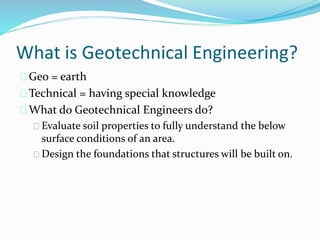The smart Trick of Geotheta That Nobody is Talking About
The smart Trick of Geotheta That Nobody is Talking About
Blog Article
The Best Guide To Geotheta
Table of ContentsMore About GeothetaThe Definitive Guide for GeothetaA Biased View of GeothetaLittle Known Facts About Geotheta.Top Guidelines Of Geotheta

They carry out website examinations, collect examples, execute laboratory examinations, and analyze data to examine the viability of the ground for construction projects - Engineer of Record. Based on their findings, geotechnical engineers offer suggestions for structure layout, incline security, keeping frameworks, and mitigation of geotechnical risks. They team up with various other specialists, such as architects, structural engineers, and building groups, to make certain that geotechnical considerations are integrated right into the total project design and execution
By evaluating the actions and residential properties of soil and rock, they can identify potential geotechnical threats such as landslides, dirt negotiation, or incline instability. Their knowledge helps avoid failures or accidents that could endanger lives and residential property. Below are some thorough duties and responsibilities of a geotechnical engineer: Site Investigation: Geotechnical designers conduct site investigations to gather data on subsurface problems.
They analyze the information to understand the homes and habits of the dirt and rock, including their toughness, leaks in the structure, compaction characteristics, and groundwater conditions. Geotechnical Analysis and Style: Geotechnical designers analyze the data gathered during site investigations to assess the stability and suitability of the website for construction projects. They perform geotechnical calculations and modeling to review variables such as birthing capability, settlement, incline security, side earth pressures, and groundwater circulation.
Geotheta Fundamentals Explained
Foundation Design: Geotechnical designers play a critical function in developing structures that can securely sustain the desired framework. They assess the dirt conditions and load demands to determine the ideal foundation kind, such as shallow structures (e.g., footings), deep structures (e.g (https://geotheta.weebly.com/)., heaps), or specialized strategies like dirt enhancement. They think about aspects such as negotiation limits, birthing ability, and soil-structure interaction to develop optimum structure designs
They review building and construction strategies, screen site tasks, and carry out field evaluations to verify that the design referrals are complied with. If unexpected geotechnical issues arise, they assess the circumstance and supply suggestions for remediation or adjustments to the layout. Threat Evaluation and Mitigation: Geotechnical engineers analyze geotechnical dangers and dangers related to the task site, such as landslides, liquefaction, or soil erosion.

Collaboration and Interaction: Geotechnical engineers work closely with various other experts involved in a task, such as designers, structural engineers, and building groups. Reliable communication and collaboration are necessary to integrate geotechnical factors to consider right into the overall project design and building process. Geotechnical engineers provide technical know-how, answer queries, and make certain that geotechnical demands are satisfied.
Geotheta Fundamentals Explained
Here are some types of geotechnical engineers: Foundation Designer: Foundation designers specialize in creating and assessing structures for structures. They assess the dirt conditions, load demands, and website qualities to figure out one of the most appropriate foundation type and style, such as superficial structures, deep structures, or specialized strategies like pile foundations.
They assess the aspects affecting slope security, such as soil buildings, groundwater problems, and incline geometry, and develop techniques to protect against incline failings and minimize risks. Earthquake Engineer: Quake engineers concentrate on analyzing and developing frameworks to endure seismic forces. They examine the seismic threat of a website, review soil liquefaction potential, and create seismic style standards to make sure the safety and resilience of frameworks throughout earthquakes.
They execute field testing, accumulate examples, and examine the collected data to characterize the soil buildings, geologic developments, and groundwater problems at a site. Geotechnical Instrumentation Designer: Geotechnical instrumentation engineers focus on monitoring and gauging the actions of soil, rock, and structures. They install and keep instrumentation systems that keep an eye on elements such as dirt settlement, groundwater degrees, slope activities, and architectural variations to analyze efficiency and provide very early warnings of possible concerns.
Geotheta Fundamentals Explained
They conduct tests such as triaxial tests, combination tests, direct shear tests, and permeability tests to gather information for geotechnical analysis and layout. Geosynthetics Engineer: Geosynthetics engineers specialize in the design and application of geosynthetic products, such as geotextiles, geogrids, and geomembranes. They use these products to enhance dirt stability, reinforce slopes, offer drainage options, and control erosion.
They often tend to be investigative people, which suggests they're intellectual, reflective, and investigative. They wonder, methodical, reasonable, logical, and rational. A few of them are additionally social, implying they're kind, generous, cooperative, patient, caring, handy, compassionate, skillful, and webpage pleasant. Does this audio like you? Take our cost-free job examination to discover if geotechnical designer is one of your leading career matches.
In the office atmosphere, geotechnical designers utilize specialized software program tools to do calculations, create designs, and assess information. They prepare records, testimonial task requirements, connect with customers and employee, and coordinate job activities. The workplace setting supplies a helpful setting for study, evaluation, and partnership with other professionals entailed in the job.
The smart Trick of Geotheta That Nobody is Talking About
They regularly see task websites to conduct site examinations, analyze geotechnical problems, and gather information for analysis. These gos to involve taking a trip to different places, in some cases in remote or tough terrains. Geotechnical designers may carry out soil sampling, conduct tests, and display construction tasks to ensure that the geotechnical facets of the task are being applied appropriately.
Geotechnical engineers likewise work in specialized geotechnical labs. Geotechnical research laboratory designers function thoroughly in these settings, handling testing equipment, operating tools, and recording data.
Report this page